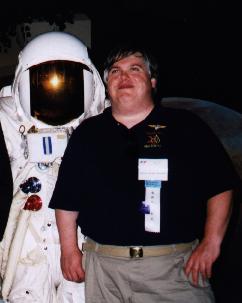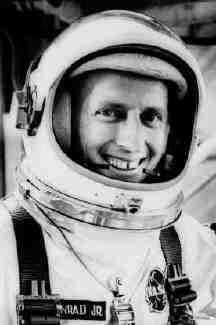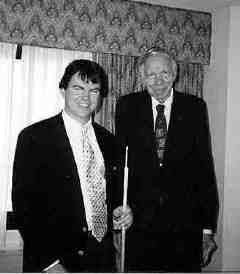Geoff Perry, MBE
1928-2000
You can read about the work of Geoff Perry MBE, teacher, "amateur" space historian, founder of the Kettering Group and co-discoverer of the Plesetsk launch site.
Dan Gauthier
1957 - 1999
Technical artiste par excellence

If you read magazines or take a newspaper, chances are you've seen the work of this man. Although I didn't get to know him for long, I count myself fortunate to have met Dan Gauthier and hung out with him at this year's ISDC in Houston. What a bummer he won't get to see the 21st century.
Charles "Pete" Conrad, Jr.
02 June 1930 - 08 July 1999
Third man to walk on another world
Commander, Apollo 12 and Skylab 2

Although Apollo 12 is more well known, Pete Conrad considered the Skylab 2 repair mission to be a much more technically demanding operation, because he had to rendezvous with and fix the damaged, overheated station before occupying it. Also flew two Gemini missions, #5 and #11. It was said that he could fly any craft ever built or the crate it came in. I had met him on a number of occasions in Washington. My funniest memory concerning him is during a hearing in 1994 concerning what happened to the Congressionally mandated funding for the Delta Clipper (Pete's eponymous SSTO project at MacDac before he started Universal Space Network/Lines/etc). One of the witnesses (Jerry Grey of the AIAA, representing the Establishment point of view) was teasing Conrad for having barely graduated college with the lowest possible GPA (BS Aero Eng '53, Princeton). The chairman of the Subcommittee, Ralph Hall (D-4-TX) interrupted in defense of Pete with "Well, frankly, I always thought that anything over 70 was wasted effort". The hearing room erupted in laughter.
In addition to Alan Shepard who passed last year, two of the Command Module pilots have also died, Jack Swigert in 1982, and Stu Roosa in 1994.
Glenn T. Seaborg
April 1912 - January 1999
Nobel Laureate, discoverer of plutonium, Chairman of the Atomic Energy Commission in the Kennedy Administration, advisor to negotiations for the 1963 Limited Test Ban Treaty, namesake for element #106 - seaborgium (Sg)

The author (left) with Glenn Seaborg (right) at the annual meeting of the American Chemical Society, Washington, DC, August 1994. The author is holding a transplutonium production rod (pre-irradiated, of course) from the 100 megawatt High Flux Isotope Reactor in Oak Ridge, Tennessee. Dr. Seaborg discovered, or had a direct hand in the discovery of, over half of the bottom row of the periodic table of the elements. In 1997, after a protracted debate, IUPAC (the International Union for Pure and Applied Chemistry which claims authority over such matters), finally gave this giant of 20th century physics & chemistry his due, and thus element number 106, provisionally dubbed unnilhexium (unh), was renamed seaborgium (Sg). At the '94 ACS meeting, Dr. Seaborg was kind enough to autograph the author's necktie with the symbol "Sg" in the appropriate spot, after expressing concern that he would ruin the tie with his Magic Marker. He didn't ruin it.
To the brave jaywalker who stopped traffic

LEST WE FORGET
04 June 1989 - 04 June 1999

Maxim Vadislavovich Tarasenko
Honored engineer, talented chronicler of space, great promise lost
20 June 1962 - 14 May 1999
Requiescat in pacem
photo copyright 1999 by the BBC, courtesy James Oberg